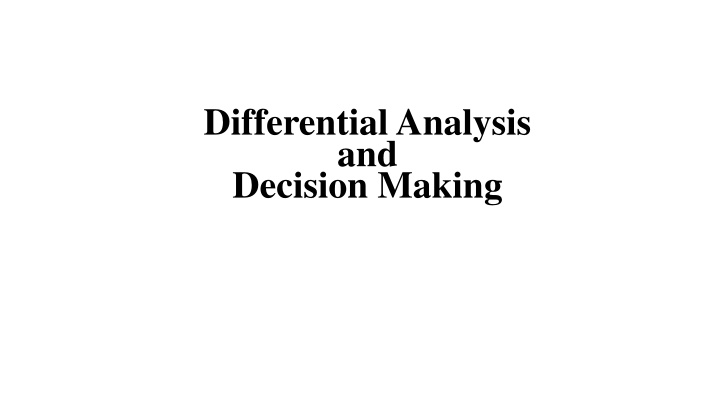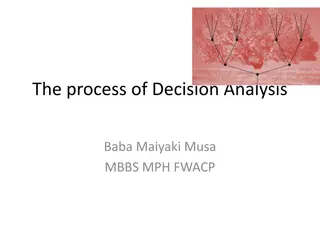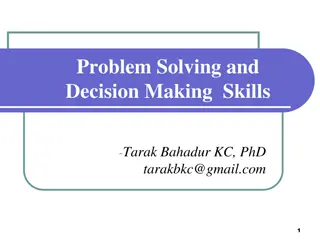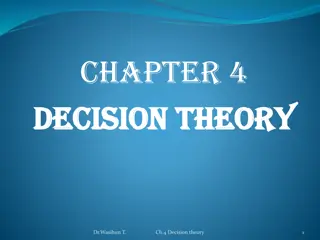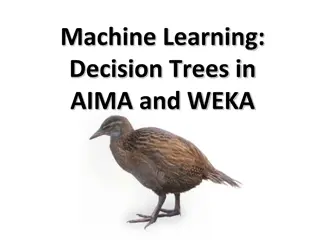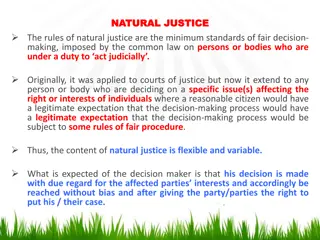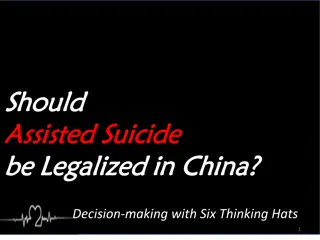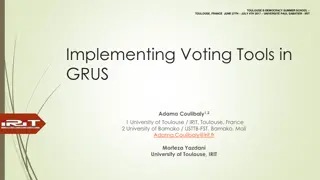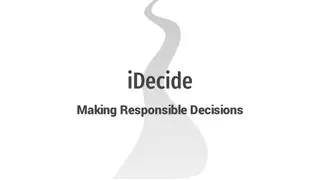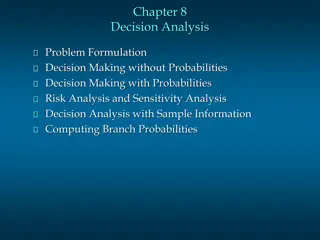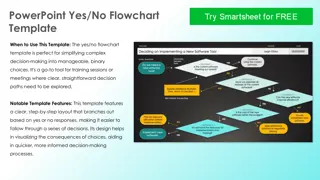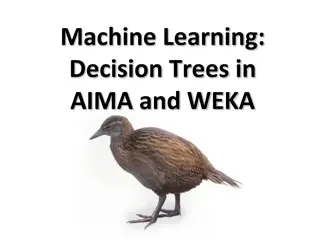Mastering Decision-Making Strategies
"Learn differential analysis techniques for decision-making, setting goals, gathering information, and identifying relevant costs. Explore target profit concepts and the stages of the decision-making process to enhance your strategic planning skills."
Download Presentation

Please find below an Image/Link to download the presentation.
The content on the website is provided AS IS for your information and personal use only. It may not be sold, licensed, or shared on other websites without obtaining consent from the author.If you encounter any issues during the download, it is possible that the publisher has removed the file from their server.
You are allowed to download the files provided on this website for personal or commercial use, subject to the condition that they are used lawfully. All files are the property of their respective owners.
The content on the website is provided AS IS for your information and personal use only. It may not be sold, licensed, or shared on other websites without obtaining consent from the author.
E N D
Presentation Transcript
Differential Analysis and Decision Making
Upon completion of this online module and in-class session, participants will be able to: Classify costs as relevant or irrelevant to a decision Understand the concept of sunk and opportunity costs Conduct differential analysis of relevant costs and revenue Analyze impact on profits of Special orders (with and without idle capacity) Outsourcing (make versus buy) decisions Sell or process further decisions Assigning limited resources to multiple products under single or multiple constraints
Decision-Making Process Stage 1 5 Setting Goals & Objectives 4 3 2 1 Stage 2 Gathering Information Stage 3 Evaluating Alternatives Stage 4 Planning & Implementation Stage 5 Obtaining Feedback
Stage 1: Setting Goals & Objectives Intangible objectives: tend to be abstract may provide guidance are difficult to measure Organizations must set objectives to provide clear guidance. Tangible objectives provide benchmarks against which to measure performance.
Target Profit and Target Cost Contract sales price Determine target selling price. Determine target cost. Determine target profit Deduct target return on sales Result is target cost Compare target cost to currently feasible total cost. The difference is the Cost-Reduction Target Redesign products and processes to achieve the cost-reduction target. Estimate based on market analysis Competitors pricing
Stage 2: Gathering Information Information Quality and Decision Usefulness Accuracy Cost vs. Quality Relevance Objectivity vs. Subjectivity Timeliness
Identification of Relevant Costs and Benefits Relevant costs are costs to be incurred at some future time and that differ for each option available to the decision maker. Costs incurred in the past are not relevant. They are called called sunk costs .
Identification of Relevant Costs and Benefits Decision: Trading an old car for a new car. Not Item Cost of new car Cost of old car Insurance AAA membership Relevant X Relevant Reason Future cost that differs between alternatives Sunk cost Increased amount to cover new car is relevant Does not differ between alternatives X X X
Stage 3: Evaluating Alternatives 1. List decision alternatives in the order the decisions must be made. 2. Trace the path of each decision to its ultimate outcome. 3. Measure the benefits and costs of each set of outcomes. Consider qualitative as well as quantitative factors.
Stage 3: Evaluating Alternatives Anticipating future outcomes of each action Completely new products Use prototype products to estimate costs. Consider consultants who have knowledge of similar products. Consider the past Although past costs are sunk and therefore irrelevant, they can be used to help estimate future costs that are relevant.
Outsourcing or Make-or-Buy Decision When the company needs goods or services, should they be made internally or bought externally? When goods or services are acquired externally, it is called outsourcing .
Outsourcing or Make-or-Buy Decision Identify the variable costs that would disappear if we outsource. Identify the new variable costs that we would incur if we outsource. Identify the fixed costs that we could avoid if we outsource.
Outsourcing or Make-or-Buy Decision Let s look at a make-or-buy decision faced by the management of Thor Company.
Outsourcing or Make-or-Buy Decision Thor Co. manufactures 20,000 of part X457 that is currently used in one of its products. The costs to make this part are: Direct materials/unit Direct labor/unit Variable overhead/unit Fixed overhead Allocated common costs $ 9.00 5.00 180,000 100,000 1.00
Outsourcing or Make-or-Buy Decision Direct materials Direct labor Variable overhead Fixed overhead ($180,000 20,000) 9.00 5.00 1.00 9.00 5.00 29.00 $ $ Thor Co. manufactures 20,000 of part 457 that is currently used in one of its products. The costs to make this part are: Common costs ($100,000 20,000) Unit cost Direct materials/unit Direct labor/unit Variable overhead/unit Fixed overhead Allocated common costs $ 9.00 5.00 180,000 100,000 1.00 Fixed manufacturing overhead is the cost of leasing and operating the equipment necessary to produce part 457.
Outsourcing or Make-or-Buy Decision Common costs are allocated on the basis of direct labor hours. Total unit cost of $29 is based on 20,000 parts produced each year. An outside supplier has offered to provide the 20,000 parts at a cost of $25 per part. Should we accept the supplier s offer?
Outsourcing or Make-or-Buy Decision Make-or-Buy Analysis - 20,000 units Make Part Buy Part Difference Direct costs: Direct materials Labor Variable overhead Fixed overhead Common costs 180,000 $ 100,000 20,000 20,000 $9 per unit 20,000 $5 per unit 20,000 $1 per unit
Outsourcing or Make-or-Buy Decision Make-or-Buy Analysis - 20,000 units Make Part Buy Part Difference Direct costs: Direct materials Labor Variable overhead Fixed overhead Common costs 180,000 $ 100,000 20,000 180,000 100,000 580,000 $ 20,000 $29 per unit
Outsourcing or Make-or-Buy Decision 20,000 $25 purchase price Make-or-Buy Analysis - 20,000 units Make Part Buy Part Difference Direct costs: Direct materials Labor Variable overhead Fixed overhead Common costs 180,000 $ 100,000 20,000 180,000 100,000 580,000 $ 500,000 $ 320,000 $ (100,000) (20,000) (180,000) 20,000 $ 100,000 600,000 $ - The common costs remain unchanged.
Outsourcing or Make-or-Buy Decision Make-or-Buy Analysis - 20,000 units Make Part Buy Part Difference Direct costs: Direct materials Labor Variable overhead Fixed overhead Common costs 180,000 $ 100,000 20,000 180,000 100,000 580,000 $ 500,000 $ 320,000 $ (100,000) (20,000) (180,000) 20,000 $ 100,000 600,000 $ - Should we make or buy part X457?
Outsourcing or Make-or-Buy Decision What is the relevant unit cost of making part X457? Direct materials Direct labor Variable overhead Fixed overhead ($180,000 20,000) Total relevant unit cost 9.00 5.00 1.00 9.00 24.00 $ $ Advantage of making 20,000 units ($25.00 $24.00) = $20,000
Outsourcing or Make-or-Buy Decision If Thor could use the space currently being used to make Part X457 for another purpose, resulting in a cost savings of $45,000, would you change your decision? Yes. The cost savings (opportunity cost) of $45,000 overcomes the $20,000 disadvantage of buying. Now there is a $25,000 advantage to buying. The real issue is the most profitable use of the space.
Pitfalls of Outsourcing Supplier technology and knowledge base may not be as anticipated. Freed-up resources are not used as planned. Customers may object. Supplier quality is not as high as anticipated. Loss of sensitive information to supplier. Customer contact may be reduced.
Decision to Add or Drop a Product, Service, or Business Unit That is why we have to consider the relevant benefits and the relevant costs BEFORE making a final decision. . . . Not to mention the bad press! If we shut down our U.S. Digital Watch line, we might anger our American customers.
Decision to Add or Drop a Product, Service, or Business Unit That is why we have to consider the relevant benefits and the relevant costs BEFORE making a final decision. Let s get started. The digital line has become less profitable and it is difficult to compete in the market. . . . Not to mention the bad press!
Decision to Add or Drop a Product, Service, or Business Unit Segment Income Statement Digital Watches Sales Less: variable expenses Variable mfg. costs Variable shipping costs Commissions Contribution margin Less: fixed expenses General factory overhead Salary of line manager Depreciation of equipment Advertising - direct Rent - factory space General admin. expenses Net loss 500,000 $ 120,000 $ 75,000 5,000 200,000 300,000 $ 60,000 90,000 50,000 100,000 70,000 30,000 $ 400,000 (100,000) $
Decision to Add or Drop a Product, Service, or Business Unit Segment Income Statement Digital Watches Sales Less: variable expenses Variable mfg. costs Variable shipping costs Commissions Contribution margin Less: fixed expenses General factory overhead Salary of line manager Depreciation of equipment Advertising - direct Rent - factory space General admin. expenses Net loss 500,000 $ If the digital watch line is dropped, the fixed general factory overhead and general administrative expenses will be allocated to other product lines. 120,000 $ 75,000 5,000 200,000 300,000 $ 60,000 90,000 50,000 100,000 70,000 30,000 $ 400,000 (100,000) $
Decision to Add or Drop a Product, Service, or Business Unit Segment Income Statement Digital Watches Sales Less: variable expenses Variable mfg. costs Variable shipping costs Commissions Contribution margin Less: fixed expenses General factory overhead Salary of line manager Depreciation of equipment Advertising - direct Rent - factory space General admin. expenses Net loss 500,000 $ The equipment used to manufacture digital watches has no resale value or alternative use. 120,000 $ 75,000 5,000 200,000 300,000 $ 60,000 90,000 50,000 100,000 70,000 30,000 $ 400,000 (100,000) $
Decision to Add or Drop a Product, Service, or Business Unit Segment Income Statement Digital Watches Sales Less: variable expenses Variable mfg. costs Variable shipping costs Commissions Contribution margin Less: fixed expenses General factory overhead Salary of line manager Depreciation of equipment Advertising - direct Rent - factory space General admin. expenses Net loss 500,000 $ 120,000 $ 75,000 Should Market retain or drop the digital watch line? 5,000 200,000 300,000 $ 60,000 90,000 50,000 100,000 70,000 30,000 $ 400,000 (100,000) $
Decision to Add or Drop a Product, Service, or Business Unit DECISION RULE Market should drop the digital watch segment only if its fixed cost savings exceed lost contribution margin. Let s look at this solution.
Decision to Add or Drop a Product, Service, or Business Unit Market Company Solution Contribution margin lost if digital watches are dropped (300,000) $ Less fixed costs that can be avoided Salary of the line manager Advertising - direct Rent - factory space Net disadvantage 90,000 100,000 70,000 $ 260,000 (40,000) $ Should we drop the digital watch segment?
Decision to Add or Drop a Product, Service, or Business Unit The same result can also be obtained by preparing a differential analysis showing operating results with and without the digital watch segment. Let s look at this approach.
Decision to Add or Drop a Product, Service, or Business Unit Differential Analysis Solution Keep Digital Watches 500,000 $ Drop Digital Watches $ Difference (500,000) $ Sales Less variable expenses: Mfg. expenses Freight out Commissions Total variable expenses Contribution margin Less fixed expenses: General factory overhead Salary of line manager Depreciation Advertising - direct Rent - factory space General admin. expenses Total fixed expenses Net loss - - - - - - - 120,000 5,000 75,000 200,000 300,000 120,000 5,000 75,000 200,000 (300,000) 60,000 90,000 50,000 100,000 70,000 30,000 400,000 (100,000) $ 60,000 50,000 30,000 140,000 (140,000) $ 100,000 70,000 260,000 (40,000) $ - - 90,000 - - - -
Decision to Add or Drop a Product, Service, or Business Unit Keeping the Digital Watch product line may have an opportunity cost that we have not yet considered. The opportunity cost of retaining the digital watch line is measured by the differential profits given up if the next best use of the production facilities is rejected. Example: If the idled facilities can be used to make a product generating $350,000 per year in contribution margin, with no other change in fixed costs, might this change your decision?
13-36 Decision to Add or Drop a Product, Service, or Business Unit Measuring cost savings and lost revenues from closing a business unit is only part of the story. The closing will impact . . . Employees personal lives, Morale of retained employees, The community at large.
Relevant Costs of Replacing Equipment Which costs are relevant to the decision to replace an old machine with a new machine? Old machine cost $5,400 when purchased. Old machine has a book value of $1,500. Purchase price of a new machine is $10,000. New machine will reduce labor from $12.00 to $11.00 per unit. New machine is expected to last two years. Repairs to old machine would be $4,600 and would allow two more years of productivity. Power for either machine is expected to be $2.50 per unit. Expected level of output: 1,000 units per year.
13-38 Relevant Costs of Replacing Equipment Which costs are relevant to the decision to replace an old machine with a new machine? Old machine cost $5,400 when purchased. Old machine has a book value of $1,500. Purchase price of a new machine is $10,000. New machine will reduce labor from $12.00 to $11.00 per unit. New machine is expected to last two years. Repairs to old machine would be $4,600 and would allow two more years of productivity. Power for either machine is expected to be $2.50 per unit. Expected level of output: 1,000 units per year Relevant because of labor savings over the 2-year life.
Relevant Costs of Replacing Equipment 1,000 units @ $12.00 for 2 years 1,000 units @ $11.00 for 2 years Keep Old Machine 24,000 $ Replace old Machine 22,000 $ Cost Labor Repair cost Purchase cost Total 4,600 $ 10,000 32,000 $ 28,600 Conclusion: keep old machine.
Pricing Decisions Product Life Cycle Product Costs Competitors Political Issues Customers What influences prices?
Pricing Decisions Prices are determined by the market, subject to costs that must be covered in the long run. Market Forces Costs Prices are based on costs, subject to reactions of customers and competitors.
Pricing Law in the United States Price Price Predatory Pricing
Special-Order Price Decisions We just received a special order. Do you think we should accept it?
Special-Order Price Decisions A travel agency offers Worldwide Airways $150,000 for a round-trip flight from Japan to Hawaii on a jumbo jet. Worldwide usually gets $250,000 in passenger ticket revenue from this flight. The airlines is not currently planning to add any new routes and has two planes that are idle and could be used to meet the needs of the agency. The next screen shows cost data developed by managerial accountants at Worldwide.
Special-Order Price Decisions Typical Flight Between Japan and Hawaii Revenue: Passenger Cargo Total Expenses: Variable expenses Allocated fixed expenses Total Profit $ 250,000 30,000 $ 280,000 90,000 100,000 $ 190,000 90,000 Worldwide will save about $5,000 in reservation and ticketing costs if the charter is accepted.
Special-Order Price Decisions Assumes excess capacity Special price for charter Variable cost per flight Reservation cost savings Variable cost of charter Contribution from charter 150,000 $ 90,000 $ (5,000) 85,000 65,000 $ Since the charter will contribute to fixed costs and Worldwide has idle capacity, the company should accept the flight.
Special-Order Price Decisions What if Worldwide had no excess capacity? If Worldwide adds the charter, it will have to cut its least profitable route that currently contributes $80,000 to fixed costs and profits. Should Worldwide still accept the charter?
Special-Order Price Decisions Assumes no excess capacity Special price for charter Variable cost per flight Reservation cost savings Variable cost of charter Opportunity cost: Lost contribution on route Total 150,000 $ 90,000 $ (5,000) 85,000 80,000 165,000 (15,000) $ Worldwide has no excess capacity, so it should reject the special charter, or try to renegotiate a higher price.
Special-Order Price Decisions With excess capacity . . . Relevant costs usually will be the variable costs associated with the special order. Without excess capacity . . . Same as above but opportunity cost of using the firm s facilities for the special order are also relevant.
Special-Order Price Decisions Additional considerations Impact on regular customers and markets Will the special order lead to future regular business?
